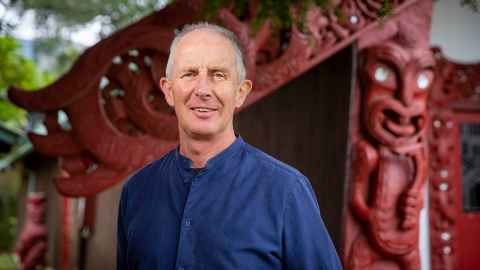Māori knew how to build, in ways we’re only beginning to understand
4 November 2020
Māori used sophisticated construction techniques often hidden from view and which have been poorly understood by Western researchers, who tended to see what confirmed their own biases about Indigenous building.

This has been revealed by Jeremy Treadwell, a senior lecturer at the School of Architecture and Planning in his PhD thesis, with which he graduated this week.
The thesis is the result of several years of research that included the first digital reconstruction of a whare runanga (the tribal assembly house), one that had existed only as a collection of carvings, and the actual building of a one third scale model whare to demonstrate previously uncelebrated building techniques.
His research demonstrates that the whare runanga was not, as is still commonly perceived, a simple post and beam structure. Rather, it involved a sophisticated way of building that used techniques and components distinct from those used in European timber frames buildings and which resulted in a remarkably stable building.
Treadwell’s research also shows how the wharenui was unique in conception and construction, such as in the way wall posts (poupou), heke (rafters) and tahu were tensioned together into a compressed arch. This made the structure very strong, rigid and resistant to deformation.
The Māori understanding of mīmiro (post-tensioning) in building was likely passed on and refined through word of mouth, and from rohe to rohe.
It was a technology resistant to orthodox European interpretations and its description restricted to a handful of texts that date back to the late 19th century and early 20th century, which were usually informed by an orthodox Western perspective on building.
Treadwell took a genuinely bicultural approach in his research, a process of exchange of both knowledge and research with different iwi.
Research included the digital reconstruction of the hapū’s whare rununga, Tāne Whirinaki. For Ngātira it was first time they had ‘visited’ their ancestor as a built entity rather than as an assembly of carvings stored in a double garage in Ōpōtiki.
This was particularly apparent in his work with the Ngātira hapū, in Ōpōtiki, where his research included the digital reconstruction of the hapū’s whare rununga, Tāne Whirinaki.
It was the first digitally-reconstructed animation of the interior of a Māori meeting house. For Ngātira it was first time they had ‘visited’ their ancestor as a built entity and which, since the 1920s, had only existed as an assembly of carvings stored in a double garage in Ōpōtiki.
The animation was a relationship-building exchange that has been professionally, personally and mutually rewarding, says Treadwell. The School of Architecture and Planning had resources, staff expertise and computer technology “and Ngātira owned a whare of great cultural and technical significance in need of a future”.
Following the presentation of the digital model, Treadwell passed on the digital file to Ngātira as well as the rights to its dissemination.
Treadwell notes that the fragmentation of Indigenous material culture has been widely documented – that which wasn’t burnt has been literally fragmented to meet the Western demand for cultural curiosities.
That includes poupou, showcased in museums for their carving, but not understood by their architectural context or merit.
The architectural innovations of the Māori meeting house were usually hidden from view, and its various components, such as the lashing, pegging and tensioning, largely located between the interior and exterior surfaces of the whare.
Unusually, Treadwell’s research involved research by making – or in his case, research through building. He (and obliging colleagues) built a one-third scale section of Tāne Whirinaki in the School of Architecture and Planning's carpark, to test the traditional tensioning techniques which his research revealed in the real world.
Treadwell knew that what literature did exist was not typically written by builders, or by people with understanding of building practices.
“There was evidence that this post tensioning system might have been used, but there wasn't much conviction anywhere in the literature that this might be applicable on a much larger scale. So it was necessary for me to become both builder and translator in the realisation of the physical model.”
“And what that showed was that rather than just being a simple post and beam kind of arrangement, the construction of wharenui involved a really sophisticated process in which the house was constructed and tensioned together in a way that created a really tight, stable and resilient structure.
“Actually building it felt like a real breakthrough in terms of my understanding of these techniques. It meant that I didn't just understand theoretically how it would work, but could understand it through actually building it.”
Media contact
Margo White I Media adviser
DDI 09 923 5504
Mob 021 926 408
Email margo.white@auckland.ac.nz